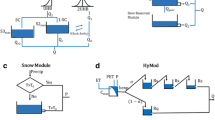Abstract
This paper attempts to investigate, in detail, the behaviour of the selected conceptual rainfall runoff model structures (a Pen manbased model and a probability distribution-based model) by using a novel method of dynamic parameter identifiability analysis (DYNIA). Two UK catchments were used as case studies. This paper shows that potential weaknesses of model structures are uncovered by this analysis; a) the optimum parameter shifts over the time domain, and b) insensitive model parameters shift over the wet period and dry period. However, attempting to interpret these results, and use them as a basis for improving the model structure proved difficult. The dynamic relationships between the model parameter and the variable soil moisture state in the model have been considered based on these analyses. Possible model modifications have been suggested: a) Making the proportion of rainfall that bypasses the soil stores responsive to soil wetness, rather than a constant, and b) Directing this bypassed rain fall to the fas trouting reservoirs rather than splitting it between fast and slow reservoirs. However, substantial and well-founded changes in the model structures had marginal effect on the time-series output. The lack of improved performance raises a number of questions and points the way forward for more research. The results may suggest that improvement of the model performance depends more on the quality of data (or catchment information) rather than the hydrological representation of the different catchments.
Similar content being viewed by others
References
Beven, K.J. and Binley, A.M. (1992). “The future of distributed models; model calibration and predictive uncertainty.”Hydrological Processes, Vol. 6, pp. 279–298.
Beven, K. (1993). “Prophecy, reality and uncertainty in distributed hydrological modelling.”Advances in Water Resources, Vol. 16, pp. 41–51.
Boughton, W. (2005). “Catchment water balance modelling in Australia 1960–2004.”Agricultural Water Management, Vol. 77, pp. 91–116.
Freer, J., Beven, K., and Ambroise, B. (1996). “Bayesian estimation of uncertainty in runoff prediction and the value of data: An application of the GLUE approach.”Water Resources Research. Vol. 32, No. 7, pp. 2161–2173.
Hornberger, G.M. and Spear, R.C. (1981). “An approach to the preliminary analysis of environmental systems.”Journal of Environmental Management, Vol. 12, pp. 7–18.
Institute of hydrology (IH) (1999) Flood Estimation Handbook, Wallingford, UK.
Jakeman, A.J. and Hornberger, G.M. (1993). “How Much Complexity is warranted in a Rainfall-runoff model?”Water Resources Research, Vol. 29, No. 8, pp. 2637–2649.
Jolley, T. (1995).Large-scale hydrological modeling—The development and validation of improved land-surface parameterizations for meteorological input. PhD Thesis, Imperial College of Science, Technology and Medicine, London, UK.
Kokkonen, T.S. and Jakeman, A.J. (2001). “A comparison of metric and conceptual approaches in rainfall-runoff modeling and its implications.”Water Resources Research, Vol. 37, No. 9, pp. 2345–2352.
Lamb, R. (1999). “Calibration of a conceptual rainfall—runoff model for flood frequency estimation by continuous simulation.”Water Resources Research, Vol. 35, No. 10, pp. 3103–3114.
Lee, H., McIntyre, N.R., Wheater, H.S., and Young, A.R. (2005). “Selection of conceptual models for regionalisation of rainfall-runoff relationships.”Journal of Hydrology, Vol. 312, No. 1–4, pp. 125–147.
McDonnell, J.J. (2003). “Where does water go when it rains? Moving beyond the variabel source area concept of rainfall-runoff response.”Hydrological Processes, Vol. 17, pp. 1869–1875.
Moore, R. (1985). “The probability-distributed principle and runoff prediction at point and basin scales.”Hydrological Sciences Bulletin, Vol. 30, No. 2, pp. 273–297.
Penman, H. L. (1949). “The dependence of transpiration on weather and soil conditions.”Journal of Soil Science, Vol. 1, pp. 74–89.
Perrin, C., Michel, C., and Andreassian, V. (2001). “Does a large number of parameters enhance model performance? Comparative assessment of common catchment model structures on 429 catchments.”Jounal of Hydrology, Vol. 242, pp. 275–301.
Perin, C., Michel, C., and Andreassian, V. (2003). Improvement of a parsimonious model for streamflow simulation.Journal of Hydrology, Vol. 279, pp. 275–289.
Senbetaa, D., Shamseldinb, A., and O’Connorc, K. (1999) “Modification of the probability-distributed interacting storage capacity model.”Journal of Hydrology, Vol. 224, pp. 149–168.
Shaw, E. (1994). Hydrology in practice, third Edition. Chapman and Hall, London.
Spear, R. and Hornberger, G. (1980). “Eutrophication in Peel Inlet—II. Identification of critical uncertainties via generalized sensitivity analysis.”Water Research, Vol. 14, pp. 43–49.
Uchida, T., Kosugi, K., and Mizuyama, T. (2001). “Effects of pipeflow on hydrological process and its relation to landslide: a review of pipeflow studies in forested headwater catchments.”Hydrological Processes, Vol. 15, pp. 2151–2174.
Wagener, T. (2002).Identification of parsimonious rainfall runoff models for gauged and ungauged catchments. PhD Dissertation. Department of Civil and Environmental Engineering, Imperial College London, UK.
Wagener, T., Wheater, H., and Gupta, H. (2004). Rainfall-runoff modelling in gaged and ungaged catchments. Imperial College Press, London, UK.
Wheater, H.S., Jakeman, A.J., and Beven, K., (1993). Progress and destinations in rainfall-runoff modelling. In: A.J. Jakeman, M.B. Beck and M.J. McAleer (Editors), Modelling Change in Environmental Systems. John Wiley and sons, Chicester, pp. 101–132.
Wheater, H.S. (2002). Progress in and prospects for fluvial flood modelling. Philosophical Transactions of the Royal Society of London Series a-Mathematical Physical and Engineering Sciences, Vol. 360, No. 1796, pp. 1409–1431.
Author information
Authors and Affiliations
Corresponding author
Rights and permissions
About this article
Cite this article
Lee, H., Moon, YI. Analysis and development of conceptual rainfall-runoff model structures for regionalisation purposes. KSCE J Civ Eng 11, 57–64 (2007). https://doi.org/10.1007/BF02823373
Received:
Accepted:
Issue Date:
DOI: https://doi.org/10.1007/BF02823373




